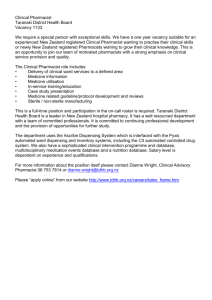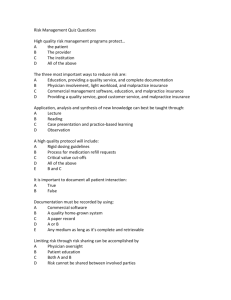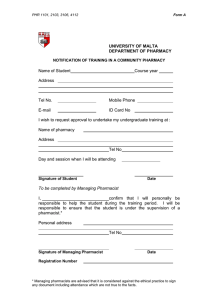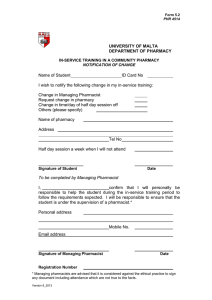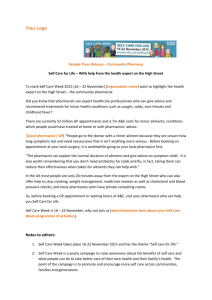Document 13276571
advertisement
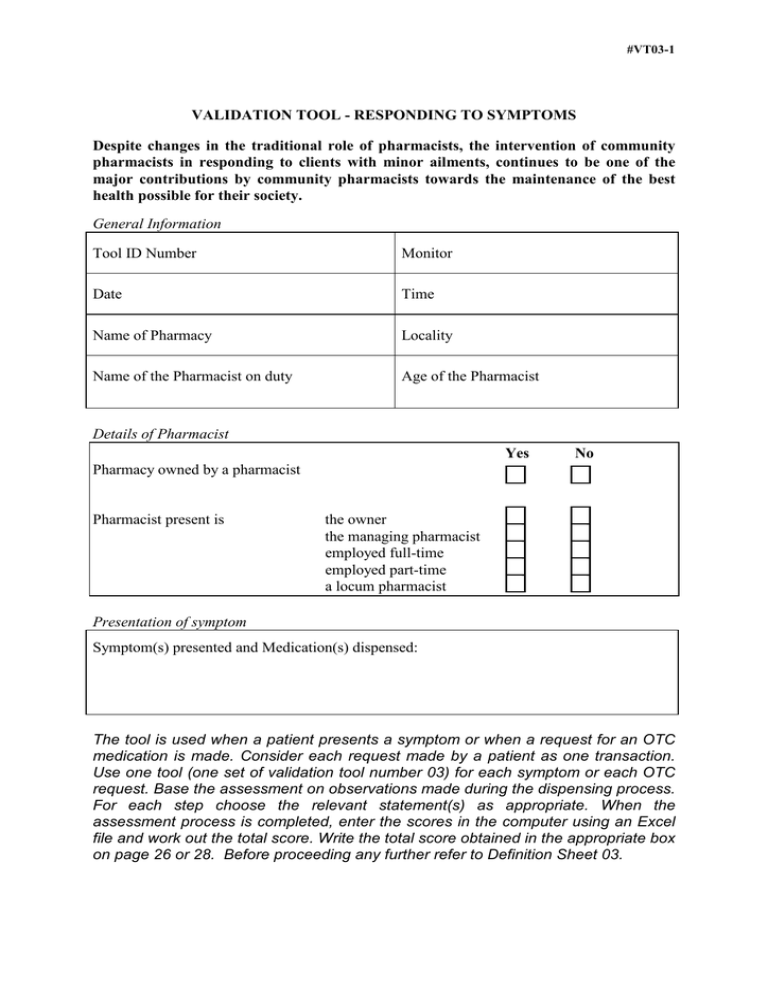
#VT03-1 VALIDATION TOOL - RESPONDING TO SYMPTOMS Despite changes in the traditional role of pharmacists, the intervention of community pharmacists in responding to clients with minor ailments, continues to be one of the major contributions by community pharmacists towards the maintenance of the best health possible for their society. General Information Tool ID Number Monitor Date Time Name of Pharmacy Locality Name of the Pharmacist on duty Age of the Pharmacist Details of Pharmacist Yes No Pharmacy owned by a pharmacist Pharmacist present is the owner the managing pharmacist employed full-time employed part-time a locum pharmacist Presentation of symptom Symptom(s) presented and Medication(s) dispensed: The tool is used when a patient presents a symptom or when a request for an OTC medication is made. Consider each request made by a patient as one transaction. Use one tool (one set of validation tool number 03) for each symptom or each OTC request. Base the assessment on observations made during the dispensing process. For each step choose the relevant statement(s) as appropriate. When the assessment process is completed, enter the scores in the computer using an Excel file and work out the total score. Write the total score obtained in the appropriate box on page 26 or 28. Before proceeding any further refer to Definition Sheet 03. #VT03-2 1 ESTABLISHING PATIENT IDENTITY Tick where applicable i The pharmacist establishes the identity of the patient 6 ii The pharmacist is familiar with the characteristics of the patient 4 2 ESTABLISHING PROFILE OF THE SYMPTOM(S) Tick where applicable i ii iii iv 3 The pharmacist asks the patient to describe the nature and severity of the symptom(s) 2 The pharmacist asks the patient about the onset and duration of the symptom(s) 3 The pharmacist asks the patient whether he experiences any accompanying symptom(s) 2 The pharmacist asks the patient whether there is anything which makes the symptom(s) worse or better 3 ESTABLISHING A TREATMENT HISTORY Tick where applicable i The pharmacist asks whether self medication was attempted 3 ii The pharmacist asks the patient whether a medical doctor was consulted for this symptom 2 The pharmacist asks the patient whether any medication was prescribed or used for this symptom in a previous occurrence 2 The pharmacist checks whether the patient is taking any other medication 3 iii iv #VT03-3 4 ESTABLISHING THE EXISTENCE OF RISK FACTORS Tick where applicable i ii The pharmacist asks whether the patient suffers from chronic conditions 5 The pharmacist asks whether the patient suffers from any allergies 5 5 DETECTION OF SERIOUS SYMPTOMS The pharmacist attempts to detect symptoms suggestive of serious disease 10 Serious Disease Tick where applicable Minor Illness GO TO 25 GO TO Ankle swelling Diarrhoea 6 Anorexia Constipation 7 Blood loss from any orifice Nausea & Vomiting 8 Difficulty in swallowing Indigestion 9 History of severe injury Cough and Colds 10 Increasing breathlessness Sore Throats and Colds 11 Loss of weight Headache 12 Menstrual abnormality Painful, frequent and urgent 13 urination Abdominal pain 14 Persistent or recurrent pyrexia Pain in chest, abdomen, head, or ears Musculoskeletal disorders 15 Spontaneous bruising Eye Disorders 16 Swelling or lumps of any size Ear Disorders 17 Tenderness over the blood vessels Skin Disorders 18 Urinary symptoms Itching around Vulva 19 Yellow or green discharge from penis or vagina Itching around Anus 20 Yellow or green sputum Foot Disorders 21 Other: Oral and Dental Disorders 22 #VT03-4 6 PRESENTING SYMPTOM IS DIARRHOEA Tick where applicable i ii iii iv v 6a The pharmacist asks the patient about the usual pattern of bowel frequency 2 The pharmacist asks the patient whether he has experienced a change in the frequency and consistency of bowel motions 2 The pharmacist enquires whether the patient has eaten anything which might have caused the diarrhoea or whether he has recently been abroad 2 The pharmacist asks the patient whether he is running a temperature 2 The pharmacist asks the patient whether he has recently lost weight for no apparent reason 2 ASSESSING SYMPTOMS Tick one Presence of accompanying symptom severe abdominal pain which is not resolving left sided pain or tenderness alternating episodes of diarrhoea and constipation significant weight loss over a few weeks blood and mucus in stools continuous and recurrent diarrhoea nocturnal diarrhoea excluding a digestive insult medication side effect other: i ii Yes No The pharmacist does not detect any of the above accompanying symptoms and decides to proceed recommending appropriate action The pharmacist detects one of the above accompanying symptoms and decides to consider referral Indicate accompanying symptom and GO TO 27 10 10 #VT03-5 6b MANAGEMENT OF THE CONDITION i The pharmacist recommends electrolyte replacement salts with or without medications to reduce diarrhoea 10 ii The pharmacist recommends regular fluid intake 5 iii The pharmacist recommends medications to reduce diarrhoea 4 GO TO 23 Tick one #VT03-6 7 PRESENTING SYMPTOM IS CONSTIPATION Tick where applicable i ii iii iv 7a The pharmacist asks the patient how often he normally goes to the toilet 3 The pharmacist asks the patient whether he suffers from bouts of diarrhoea alternating with constipation 2 The pharmacist asks the patient whether there were recent events and changes in lifestyle which may have coincided with the onset of constipation 3 The pharmacist checks the hydration status of the patient 2 ASSESSING SYMPTOMS Tick one Presence of accompanying symptom blood in faeces acute distension of the abdomen severe pain mild to moderate pain for more than 48 hours nausea and vomiting unexplained weight loss recurrent bouts of constipation constipation alternating with diarrhoea medication side effect other: i ii Yes No The pharmacist does not detect any of the above accompanying symptoms and decides to proceed recommending appropriate action The pharmacist detects one of the above accompanying symptoms and decides to consider referral Indicate accompanying symptom and GO TO 27 10 10 #VT03-7 7b MANAGEMENT OF THE CONDITION Tick where applicable i The pharmacist informs the patient to increase fluid and fibre intake and reduce intake of refined carbohydrates 5 The pharmacist explains to the patient the importance of engaging in some form of exercise 3 The pharmacist supplies a bulk forming laxative and informs the patient to drink plenty of fluids 2 iv The pharmacist supplies a stimulant laxative for 4 days 2 v The pharmacist supplies glycerine suppositories 2 ii iii GO TO 23 #VT03-8 8 PRESENTING SYMPTOM IS NAUSEA AND VOMITING Tick where applicable i ii The pharmacist asks the patient whether he can associate the symptom with food intake 4 The pharmacist checks whether the patient was recently abroad 4 iii 8a The pharmacist asks the patient whether any blood stained vomit occurred 2 ASSESSING SYMPTOMS Tick one Presence of accompanying condition blood - stained vomit frequent vomiting for more than 24 hours sudden vomiting without nausea episodic or chronic vomiting accompanied by weight loss recent traveller to hot countries medication side effect other: i ii 8b The pharmacist does not detect any of the above accompanying conditions and decides to proceed recommending appropriate action The pharmacist detects one of the above accompanying conditions and decides to consider referral Indicate accompanying condition and GO TO 27 Yes No 10 10 MANAGEMENT OF THE CONDITION Tick where applicable i ii iii The pharmacist gives advice to the patient about which food to avoid such as milk, heavy or fatty meals 4 The pharmacist gives advice to the patient what he could eat when hungry such as bread, toast or plain biscuits 4 The pharmacist recommends electrolyte replacement salts with or without medications containing antihistamines and antimuscarinics 2 #VT03-9 GO TO 23 #VT03-10 9 PRESENTING SYMPTOM IS INDIGESTION Tick where applicable i The pharmacist asks the patient whether he can pinpoint exactly where the discomfort is 3 ii The pharmacist asks the patient whether it is relieved by food 2 iii The pharmacist asks the patient whether he has eaten anything which may have caused the upset 2 The pharmacist asks if this is the patient’s first experience of indigestion 3 iv 9a ASSESSING SYMPTOMS Tick one Presence of accompanying symptom vomiting or constipation tiredness with gastro-intestinal blood loss in vomit or stool pain which spreads to jaw, neck, shoulder, and arms severe, continuous pain Other: i ii 9b The pharmacist does not detect any of the above accompanying symptoms and decides to proceed recommending appropriate action The pharmacist detects one of the above accompanying symptoms and decides to consider referral Indicate accompanying symptom and GO TO 27 Yes No 10 10 MANAGEMENT OF THE CONDITION Tick where applicable i ii The pharmacist recommends avoidance of stress, smoking, coffee, and spicy meals 4 The pharmacist recommends small regular non-spicy meals and engagement in exercises to induce weight reduction 4 iii The pharmacist recommends antacids with or without H2 antagonists GO TO 23 2 #VT03-11 10 i PRESENTING SYMPTOM IS COUGH AND COLD Tick where applicable The pharmacist asks the patient whether he has nasal congestion, nasal discharge and sore throat 2 The pharmacist asks the patient whether he has any cough and if so to describe the type of cough 2 iii The pharmacist asks the patient whether he is running a fever 3 iv The pharmacist asks the patient whether he suffers shortness of breath or chest pain 3 ii 10a ASSESSING SYMPTOMS Presence of accompanying symptoms cough which has not improved over 2-3 weeks long-standing recurrent cough persistent blood stained sputum sore throat causing difficulty to swallow wheezing and shortness of breath pain on coughing unexplained weight loss other: i ii 10b Tick one Yes No The pharmacist does not detect any of the above accompanying symptoms and decides to proceed recommending appropriate action The pharmacist detects one of the above accompanying symptoms and decides to consider referral Indicate accompanying symptom and GO TO 27 10 10 MANAGEMENT OF THE CONDITION Tick where applicable i The pharmacist gives advice to the patient about symptomatic treatment such as increasing fluid intake and performing steam inhalations The pharmacist recommends a suitable cough and cold preparation GO TO 23 5 ii 5 #VT03-12 11 PRESENTING SYMPTOM IS SORE THROAT AND COLDS Tick where applicable i ii The pharmacist examines the patient’s throat and tonsils The pharmacist asks the patient whether he has any difficulty in swallowing 5 5 11a ASSESSING SYMPTOMS Tick one Presence of accompanying symptom white pus filled spots on tonsils persistent hoarseness difficulty in swallowing large tender lymph nodes in the neck earache persistent sore throat other: i ii 11b Yes No The pharmacist does not detect any of the above accompanying symptoms and decides to proceed recommending appropriate action The pharmacist detects one of the above accompanying symptoms and decides to consider referral Indicate accompanying symptom and GO TO 27 10 10 MANAGEMENT OF THE CONDITION Tick where applicable i The pharmacist advises the patient to avoid smoky or dusty atmospheres and stop or reduce smoking if he is a smoker 3 ii The pharmacist recommends high fluid intake 4 iii The pharmacist recommends sore throat lozenges, with or without a cold medicine 3 GO TO 23 #VT03-13 12 PRESENTING SYMPTOM IS HEADACHE Tick where applicable i ii iii iv v The pharmacist asks the patient to pinpoint where the headache is 2 The pharmacist asks the patient whether he has experienced similar episodes previously 2 The pharmacist asks the patient whether the headache is mild and annoying or severe and debilitating 2 The pharmacist asks the patient whether he has suffered any possible trauma or accident 2 The pharmacist asks the patient whether he suffers from hypertension 2 12a ASSESSING SYMPTOMS Tick one Presence of accompanying condition Yes patient is a child first time episode change in nature and pattern of headache early morning headache which subsides during the day and there is no evidence of sinus and nasal congestion patient has a history of hypertension intense occipital headache accompanied by nausea and vomiting accompanied by nose bleeds accompanied by drowsiness, muscle weakness accompanied by fever and neck stiffness medication side effect other: i ii The pharmacist does not detect any of the above accompanying conditions and decides to proceed recommending appropriate action The pharmacist detects one of the above accompanying conditions and decides to consider referral Indicate accompanying condition and GO TO 27 No 10 10 #VT03-14 12b MANAGEMENT OF THE CONDITION Tick where applicable i ii The pharmacist pinpoints possible causal factors and discusses with the patient how to avoid further headache attacks 5 The pharmacist recommends an analgesic and advises the patient on the proper use of the analgesic 5 GO TO 23 #VT03-15 13 PRESENTING SYMPTOM IS PAINFUL, FREQUENT AND URGENT URINATION Tick where applicable i ii iii iv 13a The pharmacist asks the patient whether there is any itching or discharge 2 The pharmacist asks the patient whether the urine appears normal 2 The pharmacist asks the patient whether he has to get up during the night to pass urine 3 The pharmacist asks the patient whether he feels very thirsty or is drinking large volumes of fluid 3 ASSESSING SYMPTOMS Tick one Presence of accompanying condition male patient vomiting fever and rigors blood in urine loin pain vaginal discharge chronic attack symptoms for more than 3 days Other: i ii Yes No The pharmacist does not detect any of the above accompanying conditions and decides to proceed recommending appropriate action The pharmacist detects one of the above accompanying conditions and decides to consider referral Indicate accompanying condition and GO TO 27 10 10 #VT03-16 13b MANAGEMENT OF THE CONDITION Tick where applicable i The pharmacist gives advice to the patient to drink large volumes of fluids 3 The pharmacist explains to the patient to try and eliminate the bacteria by double micturition 2 iii The pharmacist counsels the patient on personal hygiene 2 iv The pharmacist recommends medications which alkalinise the urine 3 ii GO TO 23 #VT03-17 14 PRESENTING SYMPTOM IS ABDOMINAL PAIN Tick where applicable i ii iii 14a The pharmacist asks the gastrointestinal illness recently patient whether he 3 The pharmacist asks the patient whether the pain is intermittent or constant 3 The pharmacist asks the patient whether the pain spreads to other parts of the body 4 ASSESSING SYMPTOMS Tick one Presence of accompanying condition pain is unbearable continuous severe pain for more than 1 hour pain has been present episodically for more than 7 days persistent pain vomiting constipation chronic back pain and occasional fainting history of myocardial infarction aggravation caused by exercise or cold patient is a child Other: i ii 14b had Yes The pharmacist does not detect any of the above accompanying conditions and decides to proceed recommending appropriate action The pharmacist detects one of the above accompanying conditions and decides to consider referral Indicate accompanying condition and GO TO 27 No 10 10 MANAGEMENT OF THE CONDITION Tick where applicable i The pharmacist recommends medication The pharmacist gives advice to the patient on lifestyle measures which the patient can take to have symptomatic relief such as drinking a lot of fluids in muscular spasms GO TO 23 5 ii 5 #VT03-18 15 PRESENTING SYMPTOM IS MUSCULOSKELETAL DISORDER Tick where applicable i The pharmacist asks the patient about the origin of the pain 3 ii The pharmacist asks the patient whether he is experiencing stiffness, tenderness, swelling, numbness or tingling 3 The pharmacist asks the patient whether he has recently sustained any injury 2 The pharmacist asks the patient whether he experienced these symptoms previously 2 iii iv 15a ASSESSING SYMPTOMS Tick one Presence of accompanying symptom back pain with bowel or bladder symptoms sudden onset of pain in jaws, neck, arms headache with back pain and muscle weakness symptoms of fatigue, fever, general malaise Other: i ii 15b Yes No The pharmacist does not detect any of the above accompanying symptoms and decides to proceed recommending appropriate action The pharmacist detects one of the above accompanying symptoms and decides to consider referral Indicate accompanying symptom and GO TO 27 10 10 MANAGEMENT OF THE CONDITION Tick where applicable i ii The pharmacist gives advice to the patient on the symptomatic management of the condition 5 The pharmacist recommends a topical or systemic preparation containing an analgesic 5 GO TO 23 #VT03-19 16 PRESENTING SYMPTOM IS EYE DISORDER Tick where applicable i The pharmacist asks the patient whether his vision has been affected 3 ii The pharmacist asks the patient whether his eyes are watering 1 iii The pharmacist asks the patient whether the pain is within the eye or if the irritation or discomfort is on the surface 3 The pharmacist asks the patient whether there has been any trauma to or around the eye 3 iv 16a ASSESSING SYMPTOMS Tick one Presence of accompanying condition pain within the eye visual disturbances (double vision, blurred vision) hazy pupils subconjunctival haemorrhage patient is a newborn baby patient is a diabetic Other: i ii 16b Yes No The pharmacist does not detect any of the above accompanying conditions and decides to proceed recommending appropriate action The pharmacist detects one of the above accompanying conditions and decides to consider referral Indicate accompanying condition and GO TO 27 10 10 MANAGEMENT OF THE CONDITION Tick where applicable i The pharmacist suggests symptomatic non drug treatment such as bathing the eye with warm water ii The pharmacist recommends suitable medication GO TO 23 5 5 #VT03-20 17 PRESENTING SYMPTOM IS EAR DISORDER Tick where applicable i The pharmacist asks the patient whether his hearing is affected 3 ii The pharmacist asks the patient whether he is feeling dizzy 3 iii The pharmacist asks the patient whether he is hearing ringing or humming noises 2 The pharmacist asks the patient whether he has suffered from recent trauma or injury 2 iv 17a ASSESSING SYMPTOMS Tick one Presence of accompanying symptom oedema in ear canal perforated ear drum otitis externa pain discharge bleeding Other: i ii 17b Yes No The pharmacist does not detect any of the above accompanying symptoms and decides to proceed recommending appropriate action The pharmacist detects one of the above accompanying symptoms and decides to consider referral Indicate accompanying symptom and GO TO 27 10 10 MANAGEMENT OF THE CONDITION Tick where applicable i ii The pharmacist gives advice to the patient on ear hygiene such as cleaning and drying the canal and not using ear plugs in case of otitis externa 5 The pharmacist recommends appropriate medication 5 GO TO 23 #VT03-21 18 PRESENTING SYMPTOM IS SKIN DISORDER Tick where applicable i ii 18a The pharmacist asks the patient whether he has had any contact with infected persons or chemicals that could have caused the lesion 5 The pharmacist asks the patient whether he can associate disorder with food intake or with medications 5 ASSESSING SYMPTOMS Tick one Presence of accompanying symptom Yes No rash with headache, fever and malaise weeping, vesicular rash psoriasis scalp ringworm drug eruptions spider naevi acne-like papules rash which did not resolve after 1 week individual lesions which are slow growing or changing in shape or colour severe pain without rash painful rash bleeding from skin lesion yellow discoloration of the skin of the face Other: i ii The pharmacist does not detect any of the above accompanying symptoms and decides to proceed recommending appropriate action The pharmacist detects one of the above accompanying symptoms and decides to consider referral Indicate accompanying symptom and GO TO 27 10 10 #VT03-22 18b MANAGEMENT OF THE CONDITION Tick where applicable i ii The pharmacist gives advice on the symptomatic management of the condition e.g. cooling for pruritus; daily washing and thorough drying in tinea infection 5 The pharmacist recommends an appropriate medication according to the diagnosis 5 GO TO 23 #VT03-23 19 PRESENTING SYMPTOM IS ITCHING AROUND THE VULVA Tick where applicable i ii iii The pharmacist asks the patient whether she can identify precisely the location of the discomfort 5 The pharmacist asks the patient whether she is experiencing any discharge 3 The pharmacist asks the patient whether she has suffered similar symptoms previously 2 19a ASSESSING SYMPTOMS Tick one Yes No Presence of accompanying symptom rashes in genital area offensive smelly discharge blood stained discharge vaginal blisters recurrent with menstruation no improvement after 1 week with abdominal pain, fever, vomiting and diarrhoea diabetic patient Other: i ii 19b The pharmacist does not detect any of the above accompanying symptoms and decides to proceed recommending appropriate action The pharmacist detects one of the above accompanying symptoms and decides to consider referral Indicate accompanying symptom and GO TO 27 10 10 MANAGEMENT OF THE CONDITION Tick where applicable i The pharmacist gives advice to the patient on measures that can be taken to reduce symptoms such as not wearing tight fitting trousers The pharmacist gives an appropriate preparation such as an intravaginal imidazole GO TO 23 5 ii 5 #VT03-24 20 PRESENTING SYMPTOM IS ITCHING AROUND ANUS Tick where applicable i ii iii 20a The pharmacist asks the patient whether he can identify the precise location of the discomfort 5 The pharmacist asks the patient whether he has any blood in stools 3 The pharmacist asks the patient whether he experiences a burning sensation at night 2 ASSESSING SYMPTOMS Tick one Presence of accompanying condition blood mixed in stools recurrent attacks of pruritus pain Other: i ii 20b Yes No The pharmacist does not detect any of the above accompanying conditions and decides to proceed recommending appropriate action The pharmacist detects one of the above accompanying symptoms and decides to consider referral Indicate accompanying condition and GO TO 27 10 10 MANAGEMENT OF THE CONDITION Tick where applicable i ii The pharmacist gives advice to the patient on anal hygienic practice 5 The pharmacist recommends a medication for threadworm infestation, or for haemorrhoids depending on the diagnosis 5 GO TO 23 #VT03-25 21 PRESENTING SYMPTOM IS FOOT DISORDER Tick where applicable i ii 21a The pharmacist asks the patient whether he is experiencing severe pain 5 The pharmacist asks the patient whether the condition is recurrent 5 ASSESSING SYMPTOMS Tick one Presence of accompanying condition bunion fungal infection with toe nail involvement gout ingrowing toe nail thrombosis patient is a diabetic Other: i ii 21b Yes No The pharmacist does not detect any of the above accompanying conditions and decides to proceed recommending appropriate action The pharmacist detects one of the above accompanying conditions and decides to consider referral Indicate accompanying condition and GO TO 27 10 10 MANAGEMENT OF THE CONDITION Tick where applicable i ii The pharmacist gives advice to the patient on symptomatic measures such as epiderma-abrasion for corns and calluses 5 The pharmacist recommends an appropriate medication according to the diagnosis 5 GO TO 23 #VT03-26 22 PRESENTING SYMPTOMS ARE ORAL AND DENTAL DISORDERS (excluding teething) Tick where applicable i ii 22a The pharmacist asks the patient whether he has any teeth restored 5 The pharmacist asks the patient whether he recently had a dental intervention 5 ASSESSING SYMPTOMS Tick one Presence of accompanying symptom lost filling dental abscess toothache post extraction haemorrhage periodontal disease gingivitis mouth ulcers such as herpes other: i ii 22b Yes No The pharmacist does not detect any of the above accompanying symptoms and decides to proceed recommending appropriate action The pharmacist detects one of the above accompanying symptoms and decides to consider referral Indicate accompanying symptom and GO TO 27 10 10 MANAGEMENT OF THE CONDITION Tick where applicable i The pharmacist gives advice to the patient on dental care 5 ii The pharmacist recommends a dental product or a suitable medication depending on the diagnosis 5 GO TO 23 #VT03-27 23 RECOMMENDATION OF A COURSE OF ACTION Tick where applicable i The pharmacist explains how to carry out home nursing and remedies only 10 The pharmacist supplies a non prescription medicine and gives details on ii action of medicines supplied 2 iii manner in which it is taken 2 iv duration of treatment 2 v possible side effects, contra-indications and interactions 2 vi economic choice 2 24 FOLLOW UP Tick where applicable i The pharmacist provides information on the health condition 3 ii The pharmacist helps the patient to feel in control of, take responsibility for and manage the situation 2 The pharmacist informs the patient to come again or seek medical advice if symptoms persist 5 iii TOTAL SCORE REMARKS #VT03-28 25 COLLABORATIVE EVIDENCE OF DIAGNOSIS OF SERIOUS/MINOR SYMPTOM Tick where applicable i ii 26 The pharmacist investigates symptom(s) as described in definition sheet 03 5 The pharmacist documents in some form the presented symptom(s) 5 RECOMMENDATION OF COURSE OF ACTION Tick one i ii iii 27 The pharmacist stresses to the patient the importance of seeking medical advice without delay 10 The pharmacist recognises deviations from normality, indicates that the symptom may be serious, and suggests the importance of seeking medical advice if such symptom(s) persists for more than 24 hours 8 The pharmacist recommends medication until the patient seeks medical attention 5 BEFORE REFERRING Tick where applicable i The pharmacist asks the patient whether he has a family doctor 6 ii The pharmacist gives advice on how home nursing should be administered and which actions should be avoided until medical advice is reached 4 #VT03-29 28 REFERRAL Tick one i ii iii 29 The pharmacist refers the patient to the patient’s regular family doctor 10 The pharmacist offers to phone and make an appointment for the patient with a general practitioner 10 The pharmacist suggests a general practitioner and provides patient with his details (i.e. telephone number, clinic times) 8 PROVISION OF GENERAL ADVICE Tick where applicable i ii The pharmacist offers additional information on the symptom(s) presented 5 The pharmacist helps patient to feel in control of the situation 5 TOTAL SCORE REMARKS
